 |
Site created 12/15/97.

page created: 3/24/09
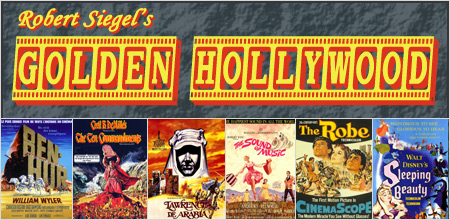 Robert Siegel - Main Page NOTE: The scans below are the property of Robert Siegel and The Digital Bits, and may not be reposted without permission. Copyright of the images belongs to the respective studios. In addition, please note that all the information contained within the text is taken from ORIGINAL studio press materials, which may contain some errors. |
||
Greetings, classic fans! This time around we take an inside look at one of the most eagerly-awaited releases of a classic on DVD, with the added excitement of a Blu-ray release. Quo Vadis was a complete success for MGM. Shot on a grand scale for pictures of its time, the film has been restored by Warner Home Video. Quo Vadis cost MGM just under $8 million to produce, and went on to become one of the biggest grossing films of the year, grossing just under $13 million. A $5 million profit in 1951 was considered extraordinary. This figure does not include foreign box office figures. MGM used the best people from their studio to produce the film, which took over a year to complete, with another year in pre-production and planning. Here's an inside look at one of MGM's more popular historic drama/adventures...
Quo Vadis Film appreciation by Robert Siegel of The Digital Bits Warner Brothers has released on Blu-ray Disc the MGM spectacle Quo Vadis starring Robert Taylor, Deborah Kerr, Leo Genn and Peter Ustinov. Based on the celebrated novel by Henryk Sienkiewicz, filmed in the grandeur of historic Rome. The film was a prodigious undertaking which required more than twelve years of preparation and actual filming, the drama tells the story of the birth of Christianity in a pagan world and the love of a Roman warrior for a beautiful Christian hostage. [Continued below...] |
||
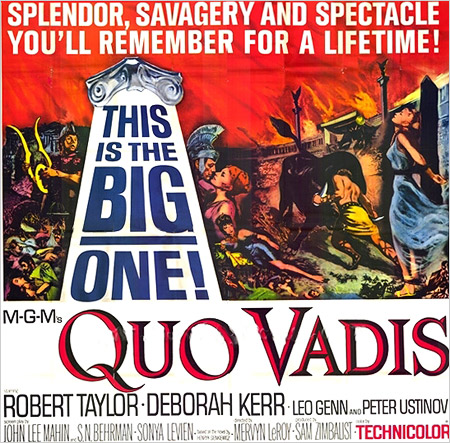 |
||
The film includes such spectacles as the triumphal procession in front of Nero's palace, the burning of Rome, the palace banquet scene and the sequences which take place in the huge Circus Maximus. All had to be mapped out on paper in advance with the same attention to minute details that a modern army might employ prior to a full-scale land and sea invasion. On most of these big scenes, four color cameras were used simultaneously to cover the sequence from every angle. For the triumphal procession alone, huge four-camera towers (one standing
150 feet high) were erected. Sixteen assistant directors, most of them Italian, were hired to work with the big crowds. They were employed to transmit orders from director Mervyn LeRoy to the thousands of extras, much in the manner of army sergeants carrying through the commands of their superiors. Typical of the complex call sheets which went to the casting department prior to the filming of the big scenes from the movie was the following, issued in connection with the procession sequence. The department was asked to procure ten Roman generals, five Egyptian dignitaries, five Syrian dignitaries, five African dignitaries, forty Praetorian guards, thirty standard bearers, seven calvary officers, seventy-five calvary men, seventy-nine members of the band, six infantry officers, ten dancing priests, ten trumpeteers, thirty-six women choir singers, ten vestal virgins, twenty-four flower girls, one hundred and fifty high-class men, five hundred and ten middle class men, and seventeen hundred low class men and a corresponding number of
women, their various classes indicated by dress. This was a huge undertaking for any movie studio and costume department and set co-ordinator. For this scene, twenty-five dancers performed an intricate routine in front of the palace prior to the procession and it was necessary for five rams, three cows and three calves to be garlanded in flowers since they were supposed to be sacrificed to Nero on an alter of fire. In addition, there were three hundred and fifty horses, many of them pulling chariots. [Continued below...] |
||

|
||
The sets for Quo Vadis were among the largest ever produced for a motion picture at the time. The reproduction of the great Circus Maximus, a huge ampitheater in which the Christian martyrs are thrown to the lions, was large enough to seat 30,000 persons. The exterior of the ornate palace of the Emperor Nero faced an avenue along which rose majestically seven giant statues of the pagan gods, each more than forty feet high. On another lot was constructed a small sized town, four blocks of ancient Rome, presenting the streets, houses and shops exactly as they appeared 2,000 years ago. Across the studio water tank, disguised as a section of the Tiber River, rose a great bridge capable of supporting 5,000 persons who had to climb it after escaping a flaming city. On one of the Cinecitta Studio's largest stages was erected the banquet hall of Nero, a room large enough to accommodate the Emperor, his 250 guests and as many servants at an elaborate feast. This set held a fifteen foot high fountain, complete with running water, three hundred twenty five separate pieces of sculpture and an individual reclining couch for each of the guests. To build these and more than one hundred other sets, a staff of five hundred skilled carpenters went to work. For almost two years, their number sometimes augmented by painters and other artisans, they worked steadily to create the great sets which provided the historically accurate background against which the story of Quo Vadis is unfolded. [Continued below...] |
||
 |
||
To say that the film was an enormous project considering special effects were rarely used would be an understatement. Four of the highest camera towers ever were constructed. A staggering total of one hundred and fifty sets and fifteen thousand costumes were required. Because of the vastness of the color production, the huge sets that were to be built, the great number of costumes and props that would have to be housed, it was imperative that the largest picture-making space be obtained to tell the story. Costume designer Herschel McCoy and a staff of eight designed the elaborate clothes worn by Robert Taylor, Miss Kerr, and the thousands of other actors. Taylor's wardrobe alone called for thirty six changes and one dress worn by Miss Kerr required four thousand tiny beads, each one applied individually by hand. Another gown, worn by Patricia Laffan as the Empress Poppaea was fashioned from a specially-woven fourteen-carat gold lame material. The job of set decorator Hugh Hunt was to round up the countless thousands of props to be used in decorating the sets, these ranging from ten ancient Roman chariots to a stuffed octopus which was served at the Emperor Nero's banquet. Most of the props used in the film were especially manufactured. Working from photographs of actual pieces on exhibit in various Italian museums, thousands upon thousands of items were manufactured in the shops, factories and even at the homes of the Italian artisans. These included two hundred goblets of Alexandria glass, fashioned expressly for the film in the famous glass-blowing plants of Venice; Four hundred and fifty different embrasures used for lighting the rooms; and more than twenty thousand yards of fine fabrics for drapes and carpets. George Emerson, who was one of Hollywood's foremost animal experts, went to Italy a year before production began to procure the many animals that were required for the film. Before his job was completed, he had traveled thirty-five thousand miles in Europe and Africa. From seven circuses scattered throughout Europe, he rounded up sixty-three lions.
[Continued below...] |
||
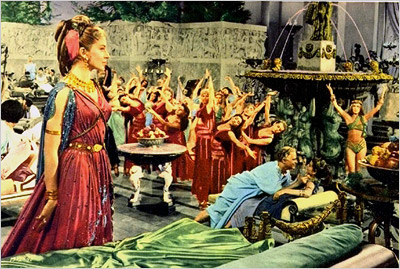  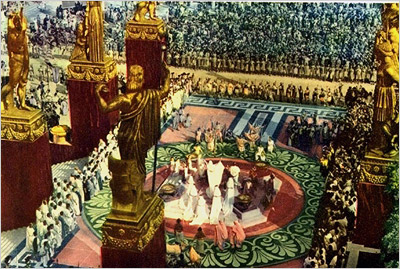 Lobby cards were spruced up with additional color. |
||
Although Nero burned Rome in six days, it took MGM three months of preparation and twenty four nights of actual shooting to re-enact the spectacular scene in the film. To understand the intensity of the work, four large blocks of the Eternal City as it is believed to have looked over two thousand years ago were reconstructed on the Cincecitta Studios outdoor lot. Shops, houses and streets were decorated with careful attention to historical accuracy. Then the company's special effects unit went to work. For three months a crew of twenty men labored continuously to mix thousands of gallons of inflatable liquid and then lay two miles of pipe to conduct it. Ten huge tanks were built and into them were poured four thousand gallons of fuel oil, two thousand gallons of gasoline, three thousand gallons of a special alcoholic mixture and more than a ton of naphthalene. In addition, fifty twenty-gallon tanks of butane gas were connected to the set. Next, it was necessary to lay two miles of small iron pipe to carry these inflammables to one hundred and twenty seven doors and windows in the four-block area. Each pipe passed through an elaborate control board which held a system of two hundred seventy five valves, every one numbered corresponding to a door or window. The pipes were wound around the inside of each window and door frame, with a pilot light located strategically at each opening to serve as an igniter. Large metal shields were hinged inside of each door and window so that they could be dropped at will and thus force the flames outside. More than a ton of asbestos was used for
weather-stripping each of the openings. During the famed twenty-hour nights of filming, Vic Millar, who headed a special unit of ninety-four men on the assignment, stood beside the cameras. At a signal from the director, he would speak over a microphone to his assistant, Tom Long. The latter operated the control panel from a vantage point high above the buildings. As Miller would call for flames to pour from window number two or door number ten, Long would press the proper valve and start the flow of liquid from the storage tanks. A total of fifty-thousand feet of the fire hose also was passed through the control board. Each hose led from a
water tank to a point on some building. As a precautionary measure, prior to each scene and immediately afterwards, Long would press the proper valve to start the water through the hose and wet down that portion of the set to be burned in that particular sequence. Windows and doors had to be painted each day so that they would be ready for the next night's work. A company from the Rome Fire Department stood-by throughout filming of the dangerous scenes. They were there just in case. Fortunately, their services were not needed. The two thousand actors involved moved in and out of the flaming buildings without mishap-something they certainly were not able to do in Nero's day.
[Continued below...] |
||
 |
||
Not only did Quo Vadis make use of more actors, more sets, more costumes and props than any other motion picture previously made, it also used more hair. An estimated three thousand wigs were fashioned from several dozen bales of hair weighing a total of 200 pounds. They adorned
the heads of the actors and actresses who portray ancient Romans in the thrilling story of the birth of Christianity in a pagan world. The hairpieces ranged from a tiny wisp of a blonde curl peeking from beneath the shawl that covers the head of a patrician lady to a wig and a lowly slave. But whether a curl or wig, the hair used had one thing in common. It all started on the head of one Italian lady. Most of it came from the peasant women of Upper Piedmont, near the French frontier. The natives of this mountainous district had long and smooth hair and for centuries have sold their locks to the wig makers of the world. Commercial travelers called at every house with blouses, scarves, cheese graters, and other household gadgets and talked the girls into swapping their hair for the gadgets or clothes. The Quo Vadis coiffures made from the vast collection of hair were the creation of hair stylists Sydney Guilaroff, of Hollywood, and Joan Johnstone of England. The Maggi firm and the Palumbi Company, two large wig-making establishments in Rome, were kept busy for months manufacturing the wigs. Patricia Laffan, who portrays the glamorous Empress Poppaea, alone wears seven wigs during the course of the picture. The Maggi outfit had been making wigs since perukes were part of the everyday dress of the average citizen. Through the years they fashioned hair pieces for kings and princes as well as the coachman and valets of the Italian Royal family. They have created hair styles for participation in religious festivals and for some of the greatest stage and operatic stars of the past. But never before had they all experienced anything like the call for wigs brought about by the filming of Quo Vadis.
[Continued below...] |
||
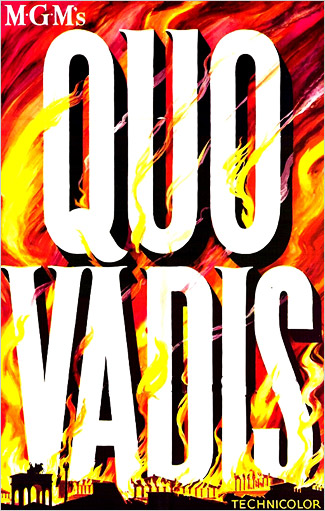 |
||
Leonardo da Vinci's famous painting of "The Last Supper" served as the inspiration for one of the most memorable scenes depicting holy moments. Used in an ingenious effect sequence, director Mervyn LeRoy reproduced "The Last Supper" in a photographed scene which captured the most
minute details of the religious painting, with the Italian actor, Giorgio Constantini portraying the Savior. Similar effect shots were used to re-create other great moments in religious history for the picture. One shows Finlay Currie, as Peter, supported by Abraham Sofaer, cast as Paul, addressing a group of Christians who are meeting in secret in an abandoned quarry. Another scene, shown during the speech of Peter to the Christians, depicts Christ passing through a shouting mob of people on the streets of Jerusalem as he carries the cross on for which he will be crucified. For the scene showing the crucifixion of Peter, famous paintings hanging in the
Vatican in Rome were used as models. The sensitively conceived and photographed religious scenes have served as lasting models for other motion pictures depicting characters from the Bible and are considered among the most inspirational ever depicted on the screen.
Any visitor from Los Angeles who happened to wander onto the Circus Maximus set while filming Quo Vadis might for a moment have imagined that he was back home seated in the Coliseum during the U.S.C.-U.C.L.A. football game. To handle the more than six thousand extras who were seated in the arena during filming of the martyrdom scenes, director LeRoy worked out a system that closely resembled seating arrangements for crowds at the U.S.C. stadium. The arena was divided into two hundred sections, each marked by either one, two or three letters. Extras, divided into groups of thirty, were given a designated number and had to remain in their designated spot during all takes of that sequence. This was necessitated by the fact that costumes had to be arranged to provide a realistic pattern for the color cameras. The banquet sequence was also quite spectacular and had some benefits for needy locals in that seven hundred pounds of food used in the scene found its way into the stomachs of needy Italian children. For the elaborate eating scene, depicting the Emperor Nero's testimonial banquet for his victorious commanders, twelve of Rome's leading chefs worked twenty four hours to prepare a cold repast that included three roasted hogs, six turkeys and fifteen baked chickens. Because of the large number of close-up shots and the fact that the film was made in color, it was decided to use actual food rather than props. At the close of the day's filming, director Mervyn LeRoy ordered any untouched food to be distributed among five relief agencies. [Continued below...] |
||
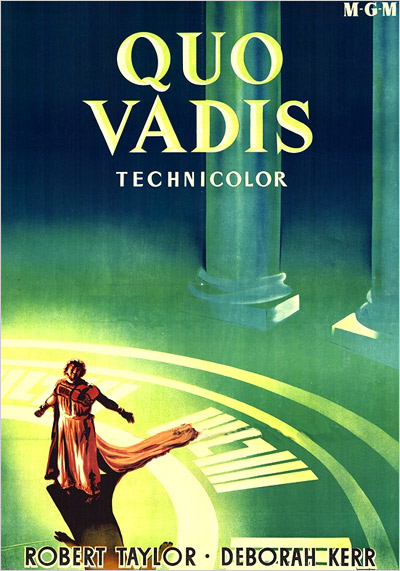
|
||
Filming did not go without problems from all of the animals used in the film. When sixty-three lions were turned loose in the huge Circus Maximus supposedly to devour the Christian martyrs, cameramen filmed the scene from behind special wire enclosures erected at either end of the arena. Under the direction of Mervyn Leroy, two units filmed the action simultaneously, with every precaution taken to avoid recurrence of a fatal mishap which occurred when the scene was filmed for an earlier production of Quo Vadis in 1924. At that time, a lion took his role too seriously and devoured one of the extras. This time, one lion also got out of hand but the cast and extras were spared any harm, but it took 2 hours to recapture the wandering animal. Trained matadors, from Portugal and Spain and animal trainers from France and Holland played the roles of the Christians inside the arena, with thousands of Italian extras impersonating Roman
spectators. Patricia Laffan, who plays Nero's wife, found that she had to go in for animal training as well as acting. In the majority of Miss Laffan's scenes she is shown leading a pair of cheetah pets on a leash. The cheetahs, captured in the jungle country near Narobi, Africa, had to accustom themselves to being led about by an actress. Consequently, Miss Laffan's rehearsals with her pets took place inside a steel cage.
Deborah Kerr had a very special place in her heart for this picture. "Quo Vadis was the sixth picture I made for MGM after coming to Hollywood from England and it was one of my most fascinating experiences. I had never made a picture as big as this one before and I was staggered at what moviemakers could do." Miss Kerr had achieved renown on both sides of the Atlantic when she was cast as Lygia in the screen version of the celebrated Henryk Seinkiewicz novel, and in the years that ensued, she increased her wide popularity all over the world. Equally endeared by critics and the public, the lovely actress had won six Academy Award nominations for her brilliant performances in such pictures as Edward, My Son, From Here to Eternity, The King and I, Heaven Knows, Mr. Allison, Separate Tables and The Sundowners. Miss Kerr was born in Helensburgh, Scotland, the daughter of Arthur Kerr-Trimmer, and Colleen Smale. [Continued below...] |
||
 Rare line art intended for newspapers to promote Quo Vadis. |
||
Her father, a civil engineer, died when Deborah was fourteen and with her mother and younger brother Teddy, she left Scotland to make her home in Sussex. An aunt in Bristol conducted a dramatic school which Deborah attended. She also studied dancing and won a scholarship to the Sadler's Wells Ballet School, which led to her first London stage appearance in the corps de ballet at the Sadler's Wells Theater in 1938. Although she was considered a promising ballerina, she found herself more interested in acting and was able to secure bit parts in the Open Air Theater in Regent's Park during the 1939 season. In 1940 she joined the repertory company at the Playhouse in Oxford. The turning point in her career occurred when her agent introduced her to producer Gabriel Pascal. He summoned her to his office for an audition. She was then cast in the role of a Salvation Army lass in Major Barbara. Following completion, she established herself on the screen in such pictures as the Life and Death of Colonel Blimp, Perfect Strangers and Black Narcissus. She next made a tour for servicemen appearing next with Steward Granger in Gaslight. By this time Hollywood was very interested in Miss Kerr and in 1946 MGM purchased the rights to the remainder of her contract. Her first Hollywood film was The Hucksters with the late Clark Gable.
Highlighting the film is a wonderful score by the renowned Miklos Rozsa, a truly epic achievement in film scoring. The film was released by MGM to much critical acclaim. Helping to promote the film were tours of the stars around the world, novels, magazine stories, record tie-ins, sheet music and a major opening night premiere party in Hollywood. The film would become one of the highest grossing films of the year, and was re-released several years later where again it did big box office business. The film has been completely remastered and restored in this new edition from Warner Home Video. [Continued below...] |
||
 |
||
|
Robert Siegel - Main Page
 |
| Site
designed for 1024 x 768 resolution, using 16M colors and .gif 89a
animation. © 1997-2015 The Digital Bits, Inc., All Rights Reserved. billhunt@thedigitalbits.com |

